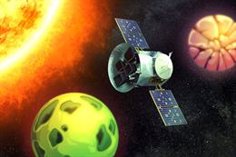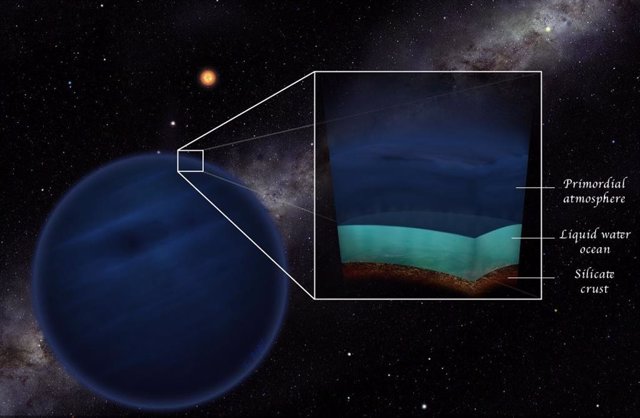Low-mass planets with a primordial atmosphere of hydrogen and helium could have the temperatures and pressures that allow water in the liquid phase. – THIBAUT ROGER – UNIVERSITÄT BERN
June 27. () –
Favorable conditions for liquid water could last for billions of years on planets that they barely resemble our home planet.
“One of the reasons water can be liquid on Earth is because of its atmosphere,” explains co-author of a new study Ravit Helled, professor of theoretical astrophysics at the University of Zurich and NCCR PlanetS member. “With its natural greenhouse effect, traps just the right amount of heat to create the right conditions for oceans, rivers, and rainsays the researcher.
However, Earth’s atmosphere used to be very different in its ancient history. “When the planet first formed from cosmic gas and dust, it assembled an atmosphere consisting mainly of hydrogen and helium, the so-called primordial atmosphere,” Helled notes. However, in the course of its development, the Earth lost this primordial atmosphere.
Other more massive planets can build up much larger primordial atmospheres, which they can maintain indefinitely in some cases. “These massive primordial atmospheres can also induce a greenhouse effect, much like Earth’s atmosphere today. So we wanted to find out if these atmospheres can help create the necessary conditions for liquid water,” says Helled, whose study is published in Nature Astronomy.
To do so, the team painstakingly modeled countless planets and simulated their development over billions of years. They took into account not only the properties of the planets’ atmospheres, but also the intensity of radiation from their respective stars, as well as the planets’ internal heat radiating outward. While on Earth, this geothermal heat plays only a minor role for conditions on the surface, it may contribute more significantly on planets with massive primordial atmospheres.
“What we found is that, in many cases, the primordial atmospheres were lost due to intense radiation from stars, especially on planets that are close to their star. But in cases where atmospheres remain, the conditions can be suitable for liquid water,” reports Marit Mol Lous, PhD student and lead author of the study. According to the researcher from the University of Bern and the University of Zurich, “in cases where enough geothermal heat reaches the surface, even radiation from a star like the sun is not necessary. so that conditions prevail on the surface that allow the existence of liquid water.”
“Perhaps most importantly, our results show that these conditions can persist for very long periods of time, up to billions of years,” says the researcher, who is also a member of NCCR PlanetS.

“To many, this may come as a surprise. Astronomers normally expect there to be liquid water in the regions around stars that receive just the right amount of radiation: not so much that the water evaporates, and not too little so it doesn’t freeze,” explains study co-author Christoph Mordasini, professor of theoretical astrophysics at the University of Bern and NCCR PlanetS member.
“Since the availability of liquid water is a likely prerequisite for life, and life likely took many millions of years to emerge on Earth, this could greatly expand the horizon for the search for extraterrestrial life forms. Based on our results.” , could even arise on so-called free-floating planets, that do not orbit around a star”, Mordasini says.
However, the researcher remains cautious: “While our results are exciting, they should be considered with a grain of salt. For these planets to have liquid water for a long time, they need to have the right amount of atmosphere. We don’t know how common it is.”
“And even under the right conditions, it’s not clear how likely it is that life would arise in such an exotic potential habitat. That’s a question for astrobiologists. Still, with our work we show that our Earth-centric idea of a life-friendly planet might be too narrow.Mordasini concludes.













![[Img #73262]](https://thelatestnews.world/wp-content/uploads/2024/07/The-era-of-artificial-intelligence-in-digital-marketing-in-Spain-300x200.jpg)
Add Comment